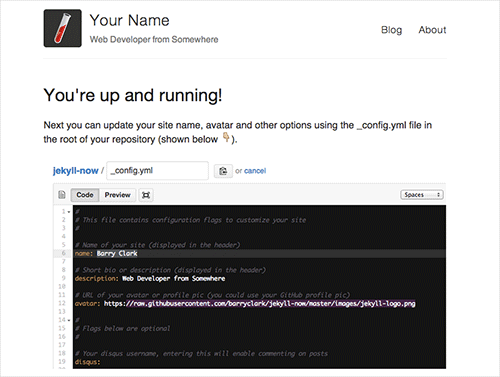

- #MAKING A WEBSITE IN RUBY JEKYLL TUTORIAL HOW TO#
- #MAKING A WEBSITE IN RUBY JEKYLL TUTORIAL INSTALL#
- #MAKING A WEBSITE IN RUBY JEKYLL TUTORIAL GENERATOR#
#MAKING A WEBSITE IN RUBY JEKYLL TUTORIAL INSTALL#
Jekyll related updates (bundle update will take a while to install required packages and plugins): :~/proj/ $ mkdir. Now I rename it to proj/ (just so that I know what project this is): :~/proj $ mv sustain Jekyll Theme: SustainĪfter browsing through a bunch of Jekyll themes, I decided on the Sustain theme.įirstly, I cloned it into a local directory: :~ $ cd /Users/greys/proj I also have done the step-by-step tutorial – give it a try, it’s really straightforward. Jekyll has a great website, including the Quick Start guide. On my MacBook, I did the following: $ sudo gem install jekyll bundler It depends on Ruby packages (gems) and uses bundle package manager.įirst, install Jekyll.
#MAKING A WEBSITE IN RUBY JEKYLL TUTORIAL GENERATOR#
Jekyll is a static website generator written in Ruby. That’s it! My new repo is public and available at the expected URL. Usernames wise, if you’re UnixGuy on GitHub, your URL will be and your repo will be /unixguy/) Still, double-check that you don’t publish any sensitive information on your Jekyll website! Kind of makes sense for most websites, cause they’re meant for public accesso on the Internet. This should be a public repository, unless you have GitHub Pro account.For a user page (not a project), it must be. The repository for GitHub Pages must follow strict naming convention.Pick a Jekyll theme, clone it into my local working directory of website repo.

setup a new GitHub repository named (it must match the GitHub username of yours, so if you’re UnixGuy on GitHub, your URL will be ).pick up and improve your git and GitHub skills as you go!.save a copy of your website (no need for your hosting backups).no need to install CMS or blogging software, unless you actually need a blog.no hosting fees – GitHub Pages are free.use GitHub and git repository for making, tracking and pushing your website changes.By default, this must be a public repository, but you can make it private if you upgrade to GitHub Pro account. It’s possible to host your basic website directly from GitHub repository. Please let me know if you find anything wrong with my approach, I’m not a software developer and have only used GitHub very little so far.
#MAKING A WEBSITE IN RUBY JEKYLL TUTORIAL HOW TO#
This past weekend I decided to finally learn how to use GitHub Pages and to publish my static website using Jekyll.


 0 kommentar(er)
0 kommentar(er)
